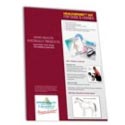Health News (Week 17 – 2014)
By Robert Redfern
For those who email asking “have I had my second test for my heart valve calcification”, to show it is all-clear, I will be going next month to have a scan and will let you know the results then. I have been unavailable each time the cardiologist has visited Palma and hope nothing gets in the way this time!
Just to be clear I have the scan personally from a cardiologist (normally it is a radiologist) who uses the latest 3D/4D EchoCardiography.
EchoCardiography
Echocardiography is a painless, non-invasive, test that uses sound waves to create moving pictures of your heart and arteries. The pictures show the size and shape of your heart. They show how well your heart’s chambers and valves are working and also, any blockages or calcifications in your arteries.
Echo can also pinpoint areas of heart muscle that aren’t contracting well because of poor blood flow or injury from a previous heart attack. A type of echo called ‘Doppler Ultrasound’ shows how well blood flows through your heart’s chambers and valves.
Echo can detect possible blood clots inside the heart, fluid build-up in the pericardium (the sac around the heart), and problems with the aorta. The aorta is the main artery that carries oxygen-rich blood from your heart to your body.
3D echocardiography (also known as 4D echocardiography when the picture is moving) is now possible, using a matrix array ultrasound probe and an appropriate processing system. This enables detailed anatomical assessment of cardiac pathology, particularly valve defects, and cardiomyopathies. The ability to slice the virtual heart in infinite planes in an anatomically appropriate manner and to reconstruct three-dimensional images of anatomic structures make 3D echocardiography unique for the understanding of the congenitally malformed heart. The 3D Echo Box developed by the European Association of Echocardiography offers a complete review of Three Dimensional Echocardiography.
3D/4D
Three-dimensional echocardiography technology may feature Anatomical Intelligence, or the use of organ modeling technology to automatically identify anatomy based on generic models. All generic models reference a dataset of anatomical information that uniquely adapts to variability in patient anatomy to perform specific tasks. Built on feature recognition and segmentation algorithms, this technology can provide patient-specific three-dimensional modeling of the heart and other aspects of the anatomy including the brain, lungs, liver, kidney, rib cage and vertebra column.
Doctors also use echo to detect heart problems in infants and children.
Should you get a scan?
I recommend everyone over aged 45 to get a scan every five years, if everything is clear, or every year if like me you need to evaluate how fast any problems are clearing. If you can get your doctor to prescribe it then you are very lucky. I use a private doctor and private cardiologist so I can tell them my requirements and have a sensible discussion about the plan I am going to follow. I listen to their opinion but politely disagree as in my case I am determined to heal the heart valve by natural methods.
| My Plan? |
| Since the calcified valve is like most other health problems such as: |
| Fibromyalgia, Premature Ageing, Heart Attack, Stroke, Cancer, Diabetes, Thyroid-related health challenges, Neurological Conditions like Parkinson’s and Alzheimer’s, Depression, Infertility, Chronic Pain, and Digestive Disorders, which all have inflammation as the core cause the BASIC plan is the same for all of them. |
I recommend:
- Serranol – x2 capsules upon waking
- SerraEnzyme 250,000iu – x1 capsule on waking and x2 at bedtime
- D-Ribose Plus – x5 teaspoons with breakfast and x5 with an evening meal.
- B4Health Spray x4 sprays x3 times over the day
- UB8Q10 (CoQ10) – x2 soft gel capsules with breakfast and x2 with dinner



Any update on your calcified heart valve mentioned on week 17?
Walter,
I am holding it from getting any worse and still trying to reverse it.
Thanks for asking
Robert
Tried high dose k2?
Hi Robert,
I had a mitral valve replaced with a metalvalve hence lifelong warfarin therapy.In your opinion what should i be taking not to worsen the current very stabilised state except
arrythmia with heart beats averaging 95 to 105. open heart surgery done 5 years ago but no problem except walking uphil can make me breathless but no pain or discomfort.
Many thanks